Abstract
AIM--To describe the phenomenon of peripheral field loss following routine pars plana vitrectomy for stage 2 and 3 full thickness macular hole and to investigate the underlying mechanism. METHODS--Five patients, who reported peripheral field defects after apparently uncomplicated vitrectomy, posterior cortical vitreous peeling, and perfluoropropane (C3F8) gas tamponade, were studied retrospectively with slit-lamp biomicroscopy, automated and kinetic perimetry, fundal fluorescein angiography, focal electroretinography (ERG), and colour contrast sensitivity (CCS) testing. RESULTS--All five patients, who were between 50 and 73 years of age, reported an inferotemporal field defect following resolution of the intraocular gas bubble. In all eyes, the scotomata encroached to within 20 degrees to 30 degrees of fixation and to within 5 degrees to 15 degrees of the blind spot. In one eye, a partial altitudinal component was evident. All scotomata subsequently remained stable and three eyes developed subtle segmental nasal disc pallor and nerve fibre loss corresponding to the field defect. CCS testing revealed absent colour contrast in the scotomatous area, in the presence of a preserved focal quadrantic flash ERG, compared with normal CCS protan thresholds and focal ERGs in unaffected quadrants, indicating preserved outer retinal function in the area of the scotoma. CONCLUSIONS--These observations support the hypothesis that field defects occur as a result of retinal nerve fibre layer damage. It is proposed, on the basis of intraoperative observations and other evidence, that the most likely site of nerve fibre damage is at the nasal portion of the optic nerve rim or peripapillary retina, probably due to traction during cortical vitreous peeling.
Full text
PDF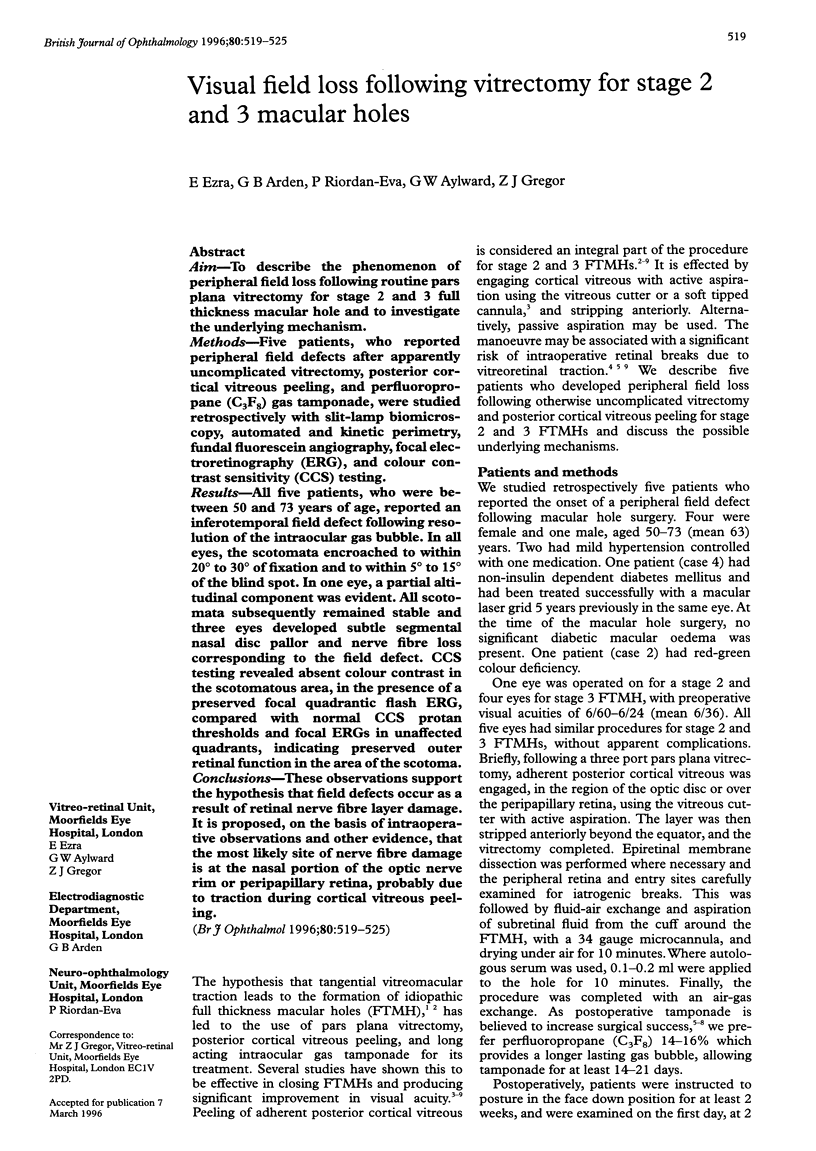
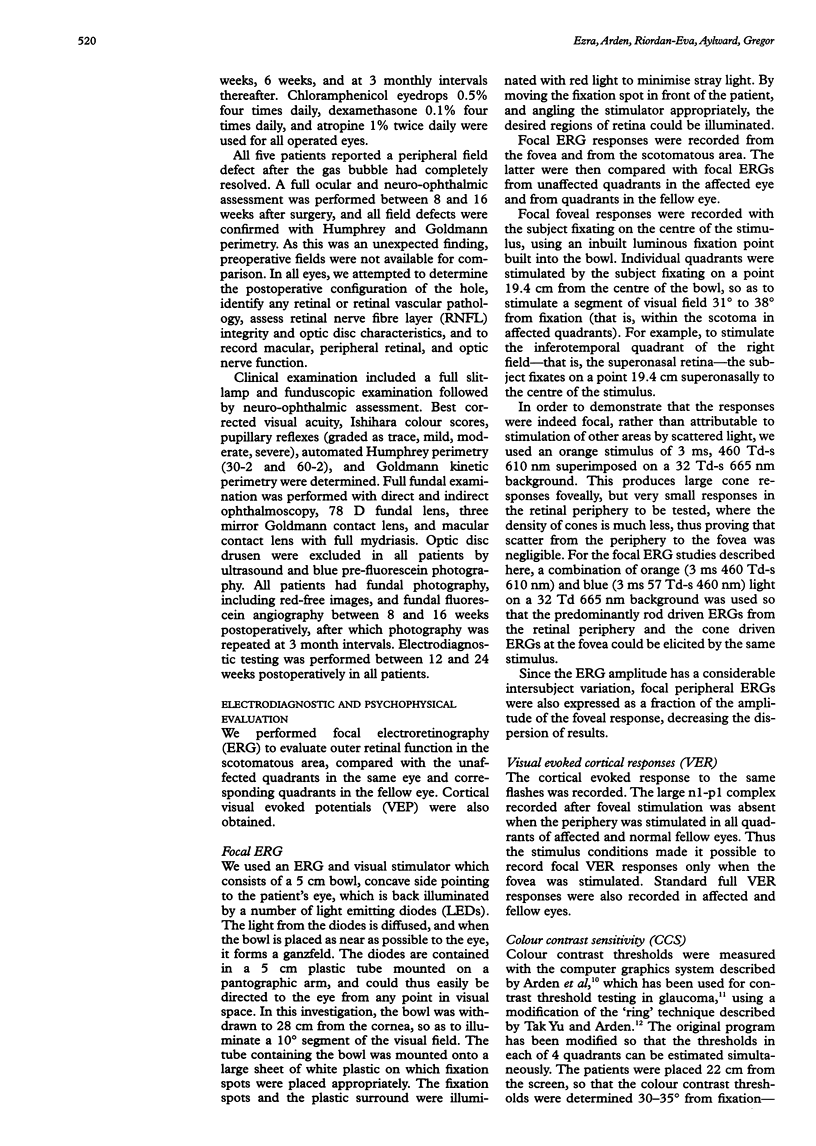
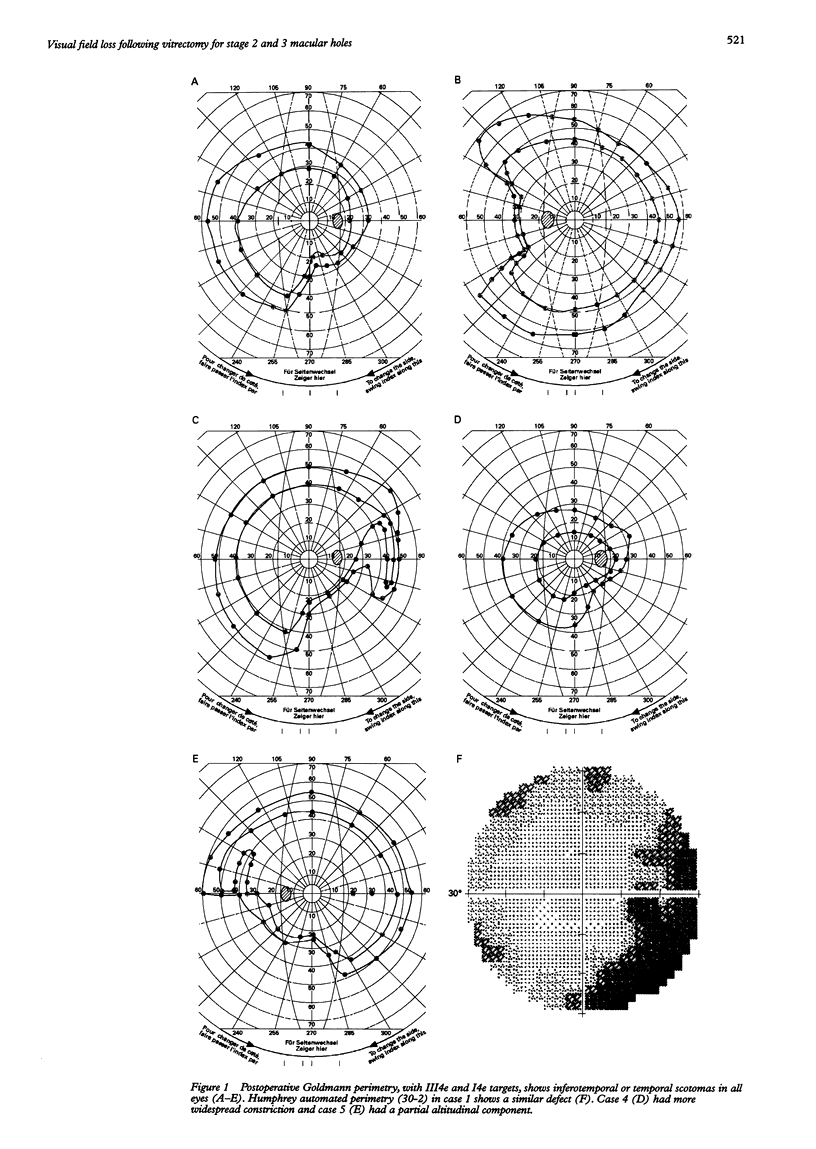
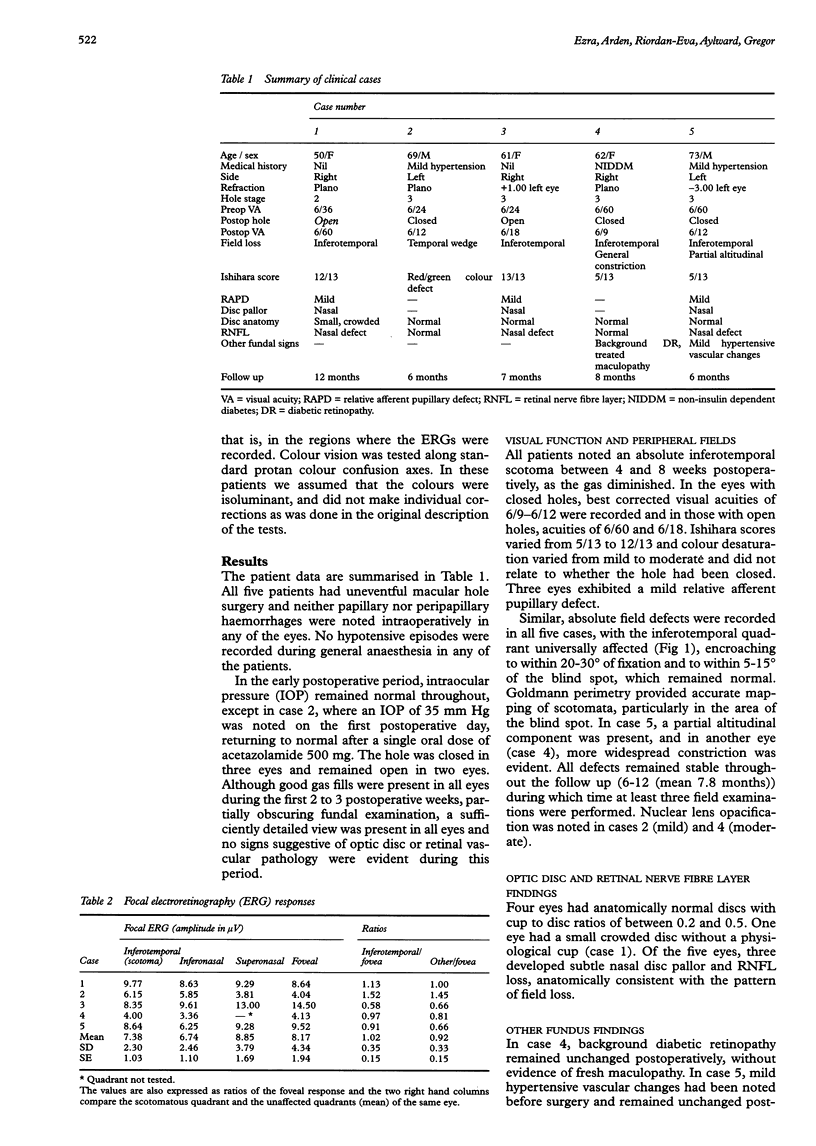
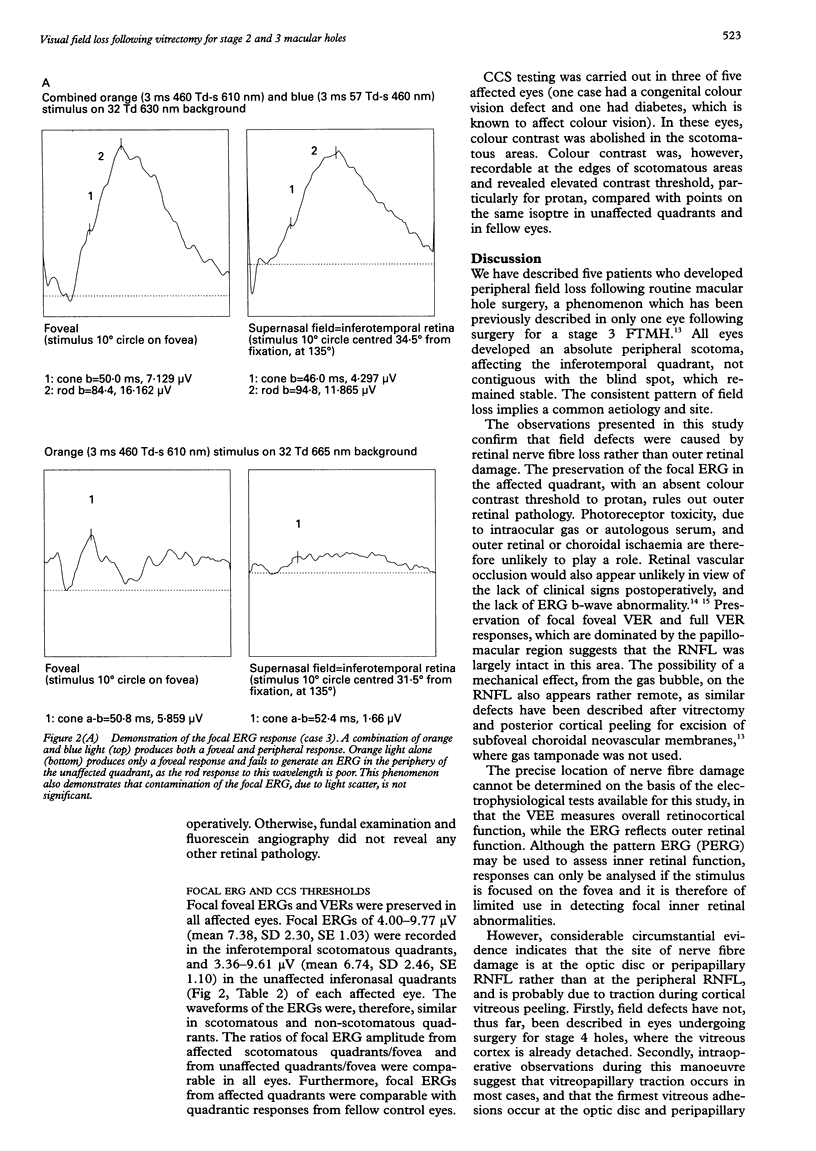

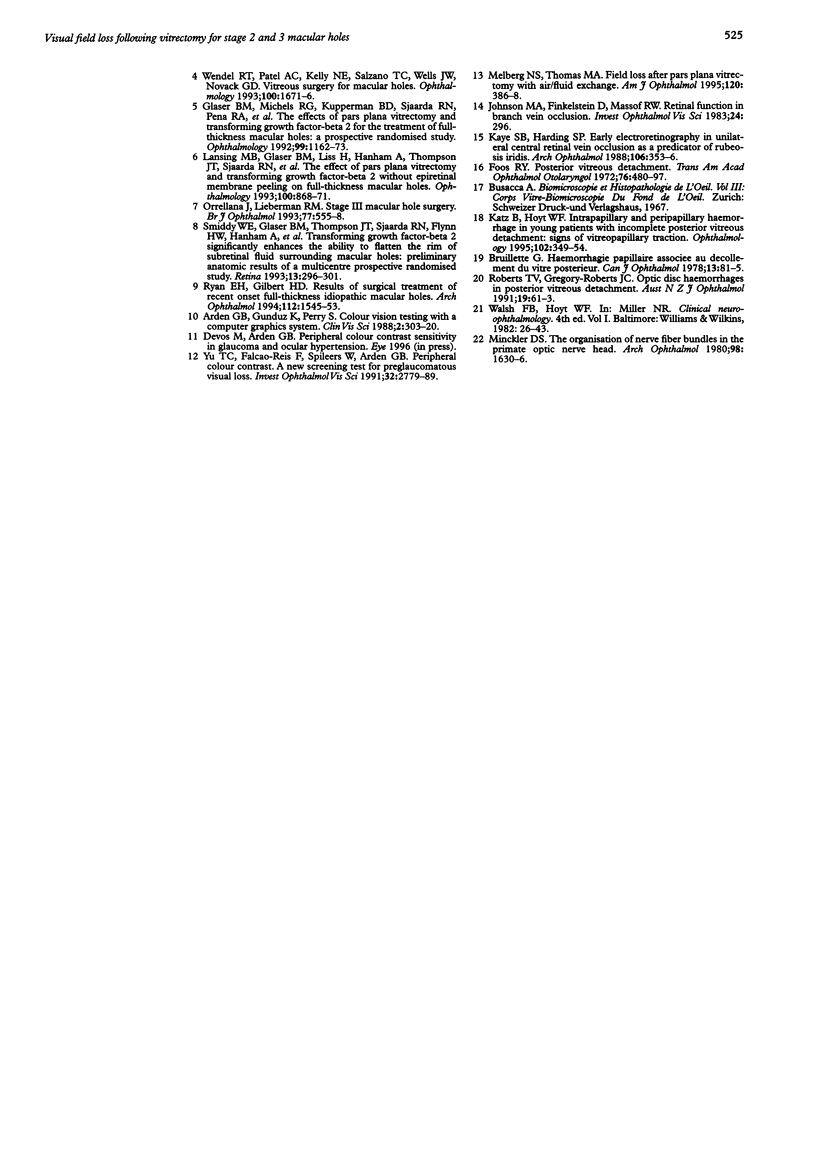
Selected References
These references are in PubMed. This may not be the complete list of references from this article.
- Foos R. Y. Posterior vitreous detachment. Trans Am Acad Ophthalmol Otolaryngol. 1972 Mar-Apr;76(2):480–497. [PubMed] [Google Scholar]
- Gass J. D. Idiopathic senile macular hole. Its early stages and pathogenesis. Arch Ophthalmol. 1988 May;106(5):629–639. doi: 10.1001/archopht.1988.01060130683026. [DOI] [PubMed] [Google Scholar]
- Gass J. D. Reappraisal of biomicroscopic classification of stages of development of a macular hole. Am J Ophthalmol. 1995 Jun;119(6):752–759. doi: 10.1016/s0002-9394(14)72781-3. [DOI] [PubMed] [Google Scholar]
- Katz B., Hoyt W. F. Intrapapillary and peripapillary hemorrhage in young patients with incomplete posterior vitreous detachment. Signs of vitreopapillary traction. Ophthalmology. 1995 Feb;102(2):349–354. doi: 10.1016/s0161-6420(95)31018-4. [DOI] [PubMed] [Google Scholar]
- Kaye S. B., Harding S. P. Early electroretinography in unilateral central retinal vein occlusion as a predictor of rubeosis iridis. Arch Ophthalmol. 1988 Mar;106(3):353–356. doi: 10.1001/archopht.1988.01060130379026. [DOI] [PubMed] [Google Scholar]
- Kelly N. E., Wendel R. T. Vitreous surgery for idiopathic macular holes. Results of a pilot study. Arch Ophthalmol. 1991 May;109(5):654–659. doi: 10.1001/archopht.1991.01080050068031. [DOI] [PubMed] [Google Scholar]
- Lansing M. B., Glaser B. M., Liss H., Hanham A., Thompson J. T., Sjaarda R. N., Gordon A. J. The effect of pars plana vitrectomy and transforming growth factor-beta 2 without epiretinal membrane peeling on full-thickness macular holes. Ophthalmology. 1993 Jun;100(6):868–872. doi: 10.1016/s0161-6420(93)31561-7. [DOI] [PubMed] [Google Scholar]
- Melberg N. S., Thomas M. A. Visual field loss after pars plana vitrectomy with air/fluid exchange. Am J Ophthalmol. 1995 Sep;120(3):386–388. doi: 10.1016/s0002-9394(14)72169-5. [DOI] [PubMed] [Google Scholar]
- Minckler D. S. The organization of nerve fiber bundles in the primate optic nerve head. Arch Ophthalmol. 1980 Sep;98(9):1630–1636. doi: 10.1001/archopht.1980.01020040482019. [DOI] [PubMed] [Google Scholar]
- Orellana J., Lieberman R. M. Stage III macular hole surgery. Br J Ophthalmol. 1993 Sep;77(9):555–558. doi: 10.1136/bjo.77.9.555. [DOI] [PMC free article] [PubMed] [Google Scholar]
- Roberts T. V., Gregory-Roberts J. C. Optic disc haemorrhages in posterior vitreous detachment. Aust N Z J Ophthalmol. 1991 Feb;19(1):61–63. doi: 10.1111/j.1442-9071.1991.tb00323.x. [DOI] [PubMed] [Google Scholar]
- Ryan E. H., Jr, Gilbert H. D. Results of surgical treatment of recent-onset full-thickness idiopathic macular holes. Arch Ophthalmol. 1994 Dec;112(12):1545–1553. doi: 10.1001/archopht.1994.01090240051025. [DOI] [PubMed] [Google Scholar]
- Smiddy W. E., Glaser B. M., Thompson J. T., Sjaarda R. N., Flynn H. W., Jr, Hanham A., Murphy R. P. Transforming growth factor-beta 2 significantly enhances the ability to flatten the rim of subretinal fluid surrounding macular holes. Preliminary anatomic results of a multicenter prospective randomized study. Retina. 1993;13(4):296–301. [PubMed] [Google Scholar]
- Wendel R. T., Patel A. C., Kelly N. E., Salzano T. C., Wells J. W., Novack G. D. Vitreous surgery for macular holes. Ophthalmology. 1993 Nov;100(11):1671–1676. doi: 10.1016/s0161-6420(93)31419-3. [DOI] [PubMed] [Google Scholar]
- Yu T. C., Falcao-Reis F., Spileers W., Arden G. B. Peripheral color contrast. A new screening test for preglaucomatous visual loss. Invest Ophthalmol Vis Sci. 1991 Sep;32(10):2779–2789. [PubMed] [Google Scholar]


